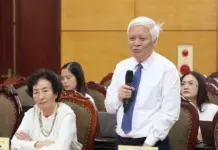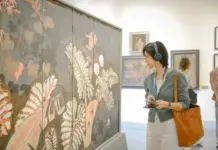Deputy Minister of Information and Communication Nguyen Huy Dung is one of the first visitors to experience the “Essence of Confucianism” night tour at Hanoi’s Temple of Literature.
“When my children see the lighting and 3D mapping technology tonight, I am sure they will be curious to know more about what the Temple of Literature is and ask themselves many questions,” Dung said.
Dung hopes that this show will become a reference for tourism that combines cultural, historical, and technological elements as technology has and will help promote stage arts and bring historical and cultural aspects closer to the people.
Engaging audience by using technology
Recently, both central and local arts organizations have stepped up the creation of fan pages on Facebook, TikTok, and other digital platforms in the theater industry to inform the public about the schedule of their performances. In addition, some theaters are broadcasting snippets of plays on social networks to get their audiences hooked.
The Vietnam Drama Theater’s fan page frequently updates information about the performance schedule, current plays, and upcoming debuts. In addition, light-hearted narratives about acting or other theater-related activities are regularly shared with the public.
| Light art applied to Khue Van Cac, the pavilion inside the Temple of Literature, as part of the newly launched night tour. Photo: Lai Tan/The Hanoi Times |
To increase interaction with the public, the Vietnam Drama Theater organizes teasers in short plays for theater lovers, with incentives in the form of tickets to the theater’s performances. This has captured a significant number of regular patrons.
According to Xuan Bac, Director of the Vietnam Drama Theater, technology improves the interaction between the theater, artists, and audiences. So far, technology has been used to raise awareness of Vietnamese theater and to disseminate information about theater events to a wider audience.
For example, the Youth Theater frequently broadcasts livestreams on the theater’s fan page to update ticket-holding audiences about upcoming performances and promotional programs.
The theater’s artists are highly proactive in promoting the play and interacting with the online audience. The theater encourages online payment and the use of QR codes for ticket validation. It’s convenient and satisfying for audiences to avoid having to call or visit the theater in person to purchase tickets.
Meritorious Artist Nguyen Si Tien, Director of the Youth Theater, highlights the theater’s keen interest in metrics such as the count of followers, the number of visitors, and the interaction rate of posts on the fan page. Aggressive promotion has had a positive impact on revenue. The theater continues identifying promotions on social networking sites as a customer service.
The Vietnam Circus Federation fan page frequently shares updates on new circus programs and exclusive performances by artists to keep them in the public eye.
| The Department of Performing Arts created a Vietnam Performing Arts Channel on YouTube and Facebook to livestream festivals online. |
During the peak period of the Covid-19 pandemic, the Department of Performing Arts launched a Vietnam Performing Arts Channel on YouTube and Facebook to livestream performing arts events online, allowing audiences nationwide to experience theater without leaving home.
Meanwhile, the Vietnam National Opera and Ballet Theater has posted QR codes on the screen before performances, allowing audiences to learn about the play’s content, cast, and order of events in advance, saving significant costs on flyer printing and encouraging active audience engagement with the show.
Challenges
According to Dr. Nguyen Lien Huong, an expert from the Culture and Arts Magazine under the Ministry of Culture, Sports and Tourism, online streaming of performing arts programs garners a massive following on social media platforms. With the help of technology such as marketing software and data collection tools, theaters can run their shows more efficiently and save time.
“Digital transformation is an imperative trend that helps the performing arts adapt to recent developments and preserve traditional values in modern life,” Huong said.
Digitalization benefits global audiences and improves theatre management. The use of advanced science and technology will make performing arts programs more attractive,” she added.
However, Huong noted that digital transformation in the field of performing arts faces many challenges, such as a lack of funding for building digital technology platforms. The technical equipment of almost all theatres in the capital is outdated, which somewhat limits audience engagement.
According to People’s Artist Tong Toan Thang, Director of the Vietnam Circus Federation, online teasers of artistic products are not catching or profitable. To generate revenue from audiences, technological investment is needed to create artistic products that align with the contemporary market.
“Modern tools are necessary for successful digital transformation in Industry 4.0. It is imperative to prioritize training and cultivating workforce expertise in digital transformation and proficiency in the use of digital platforms,” Toan said.
Experts have agreed that theatres and artists should consider changing the standard of their programming to accommodate digital platforms. Each arts program must be thoughtfully choreographed with the online environment and advanced digital technology in mind, and, at a minimum, be able to evoke the sensation of experiencing it as if it were in a live theatrical setting.
Audiences should be able to view plays digitally after creating an account and making a payment. This approach allows the theater to protect play copyrights and generate revenue from fees and advertising.
Huong asserted that innovation, technology access, and digital transformation are the keys for the performing arts to overcome the challenges of integration and the threat of being overshadowed by myriad other entertainment media.
Using digital transformation technology to bring performing arts works to the online environment is essential to making artistic products accessible to today’s audiences. While there are obstacles, this is an opportunity for arts organizations and artists to prove themselves and highlight the nation’s artistic and cultural values.
People’s Artist Tran Bang: Artists should keep faith in traditional stage
NDO – Prof, People’s Artist Tran Bang, who has worked as a director of Cheo (Vietnamese traditional opera) for more than 50 years, granted an interview with a Nhan Dan (People) Newspaper reporter, sharing about the direction for the development traditional stage in the context that young audiences are no longer interested in because they have many choices for entertainment.
Hunt Launched for New Talent in Traditional Arts
NDO – The 2017 national competition for professional stage actors of Tuong (classical drama) and Cheo (traditional opera) was launched on August 5, at Lam Son theatre in Thanh Hoa province.










